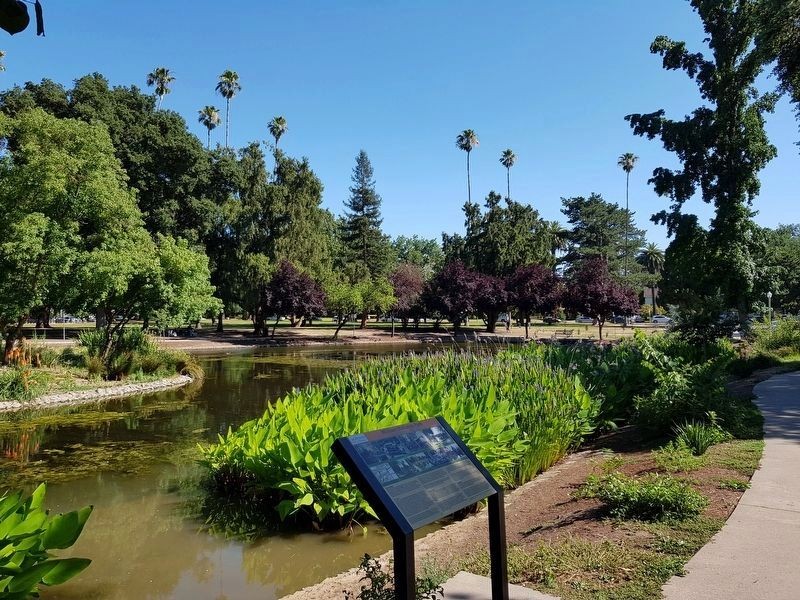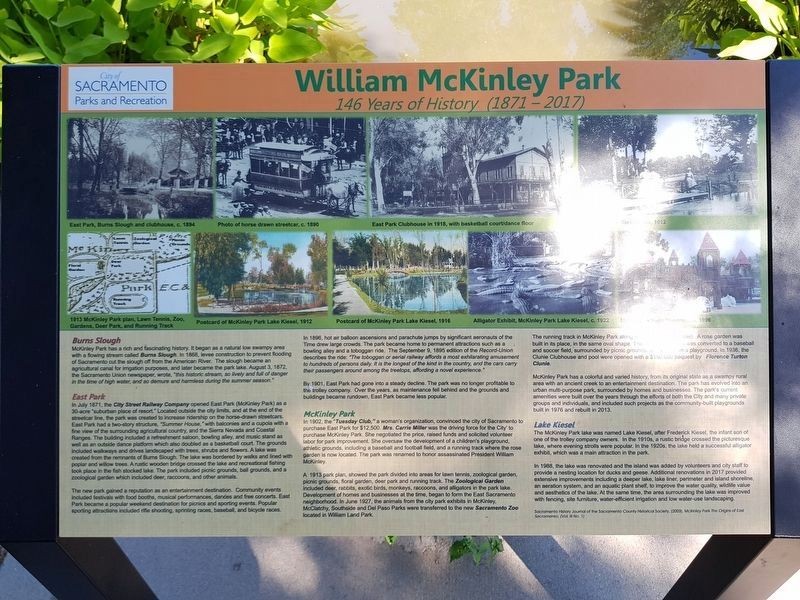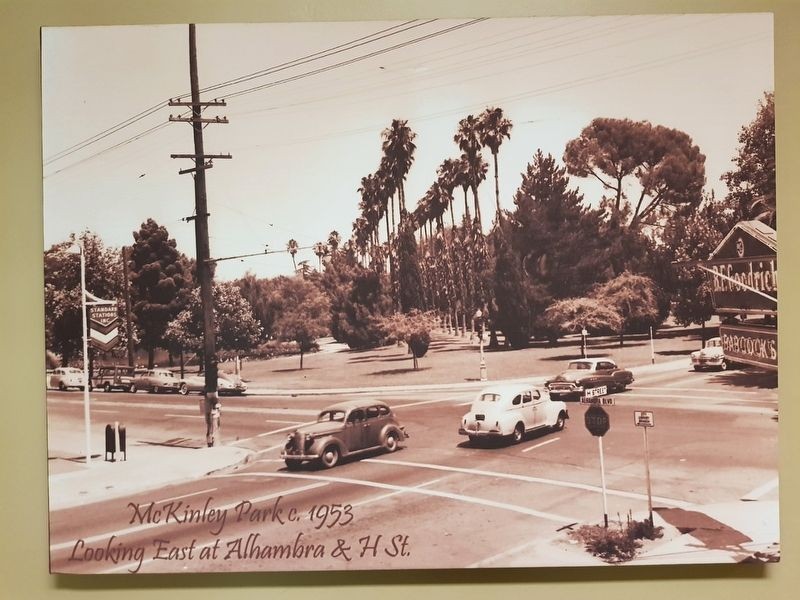William McKinley Park and Historical Marker
Introduction
Text-to-speech Audio
Sacramento's McKinley Park evolved from the earlier East Park, established in 1871 when the Sacramento Street Railway Company purchased an undeveloped parcel of land on the outskirts of the city. The company hoped to create a landscape that would compel Sacramento residents to escape the city on weekends by riding horse-drawn streetcars to the park. In 1902, the city acquired the existing East Park and renamed it in honor of President McKinley. In 1913, a zoo was added, along with a rose garden in 1928 and tennis courts in the 1940s. An existing lake was expanded in 1988 to create a nesting area for geese and ducks. Additional renovations in 2017 improved the lake's water quality and appearance, while attracting more wildlife. Today, the park features a weekly Saturday farmers’ market, a tour of the park’s trees, and musical concerts on summer evenings. The park was added to the National Register of Historical Places in 2018, and a marker near the lake shares the history of the park since its establishment over 150 years ago.
Images
William McKinley Park Historical Marker

William McKinley Park Historical Marker / Interpretive Sign

McKinley Park, circa 1953, Looking East at Alhambra and H Street

Backstory and Context
Text-to-speech Audio
Established in 1872 as East Park (due to its location east of downtown Sacramento), McKinley Park is one of the oldest parks in the western United States. Only San Francisco’s Golden Gate Park is older, having been established the year before. Sacramento’s East Park was created when the Sacramento Street Railway Company purchased an undeveloped parcel of land on the outskirts of the city. The company hoped to create a landscape that would compel Sacramento residents to escape the city on weekends by riding horse-drawn street cars to the park. During the late 19th and early 20th century, streetcar companies often created parks as "pleasure grounds" and "places of resort" while appealing to the growing public interest in outdoor recreation and leisure.
Originally a low, swampy, vegetated area, the land that became East Park included a flowing stream known as Burns Slough. In 1868, the city of Sacramento constructed a levee to prevent the flooding of the American River. This had the effect of cutting off the Burns Slough from the rest of the river. The result was the creation of an irrigation canal that could be used for agricultural purposes. It also resulted in the formation of Lake Kiesel. Anchored by this lake, the newly created East Park featured curved paths, informal tree groupings, meadows, and other naturalistic elements associated with the Picturesque style of landscape design that was popular at the time.
The 32-acre park had a two-story "summer house" with balconies and a cupola that offered views of local farms and the Sierra Nevada Mountains. The building included a bowling alley, saloon, and music stand, with an outdoor dance platform that doubled as a basketball court. In 1902, a women’s organization, the Tuesday Club, persuaded the city of Sacramento to purchase the site. Thereafter, it was renamed McKinley Park in honor of President William McKinley, who was assassinated in 1901. The park offered baseball fields, a zoo (1913), picnic areas, and recreational fishing in the lake. Sacramento’s Superintendent of Parks, Frederick N. Evans, added a rose garden in 1928, and the park underwent further improvements via the Works Progress Administration in the 1930s.
During the 20th century, tennis courts, a community center, a pool, and soccer fields were also added to McKinley Park. Today, the landscape contains several examples of mature trees, some that were planted a century ago. The original streetcar route that ran alongside the park and that was once lined with date palm trees has since been converted into a parking area, but some of the date palms remain. In addition, ginkgo, sycamore, and mulberry trees flourish around the park's perimeter. Visitors can enjoy a tree tour, which includes species such Ponderosa pine, California redwood, London plane, and English elm. A farmers’ market takes place on Saturday mornings, and musical events are held on summer evenings. The park was added to the National Register of Historical Places in 2018, and a marker near the lake shares the history of the park since its establishment over 150 years ago.
Sources
Bruton, J. Makali. "William McKinley Park Historical Marker", Historical Marker Database. August 5th, 2019. Accessed August 17th, 2023. https://www.hmdb.org/m.asp?m=137570.
Johnson, Ashley . "McKinley Park", Outdoor Project. Accessed August 17th, 2023. https://www.outdoorproject.com/united-states/california/mckinley-park.
"McKinley Park", TCLF. Accessed August 17th, 2023. https://www.tclf.org/mckinley-park.
"McKinley Park, Bounded by Alhambra Boulevard, McKinley Boulevard, 35th Street, Park Way, 33rd Street, and H Street, Sacramento, Sacramento County, CA", Library of Congress. Accessed August 17th, 2023. http://loc.gov/pictures/item/ca4325/.
J. Makali Bruton / Historical Marker Database
J. Makali Bruton / Historical Marker Database
J. Makali Bruton / Historical Marker Database
